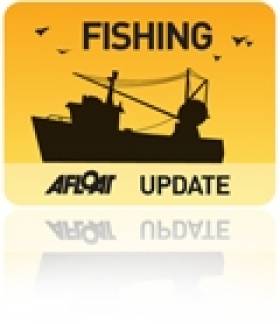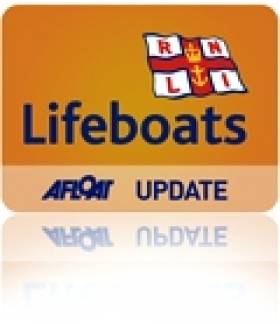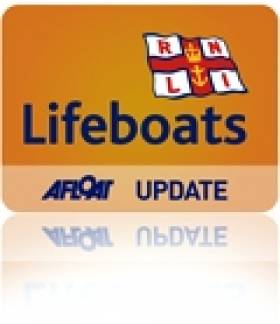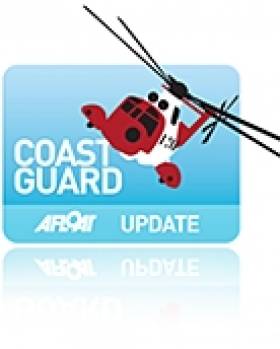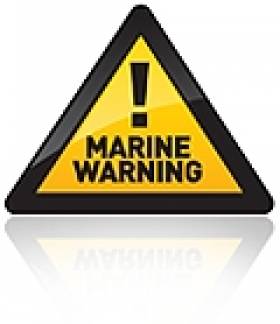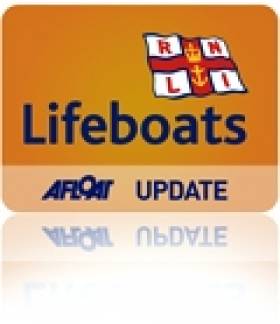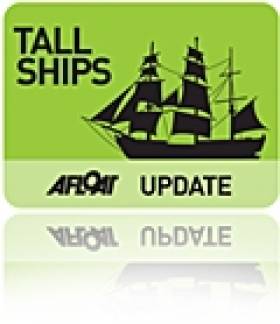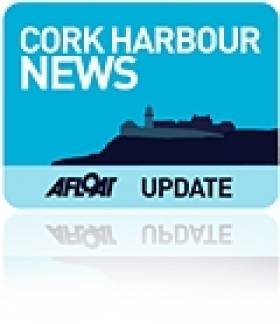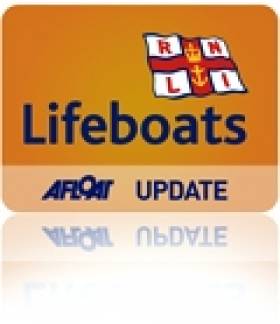Displaying items by tag: RNLI
‘Angelus’ Trawler Also Appears On Pierside Gallery
Apart from the mural of the trawler (click HERE) there are a wide variety of vessels represented from general cargo-ships and the inclusion of STV Asgard II and the World's last ocean-going paddle-steamer P.S. Waverley. These vessels have too berthed alongside the adorned eastern breakwater where spectators flock to see the start of the biennial Round Ireland Yacht Race which was held last year.
The photo of the trawler was taken on a previous call at the Packet Quay, Wicklow and not Arklow as stated. The Packet Pier is the most used commercial quay in the Co. Wicklow port, where timber and scrap-metal cargoes are relatively common. For example the Arklow Rebel which loaded scrap-metal bound for Liverpool, to read more click HERE.
Wicklow Lifeboat Assists Fishing Vessel after Collision with Tanker
The alarm was raised after the collision took place about 20 miles off the Welsh Coast in the early hours of Monday morning. A volunteer crew from Holyhead RNLI lifeboat Station put to sea along with Wicklow lifeboat.The 3 crew of the beam trawler were uninjured in the incident, but the vessel sustained some damage to fishing gear, but no damage below the waterline. The tanker was able to resume her passage and no damage or pollution was reported.
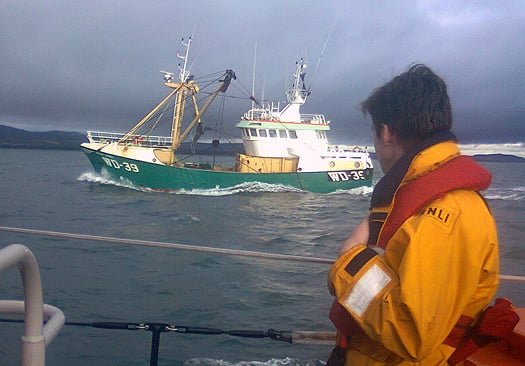
Wicklow RNLI lifeboat escorting the fishing vessel. Photo: RNLI/ Wicklow
The trawler was able to motor back towards the Irish Coast under escort by Holyhead lifeboat. At 07.33hrs Wicklow lifeboat arrived on scene. Holyhead lifeboat was then stood down and returned to station.
Wicklow lifeboat escorted the Beam trawler on the journey back to Wicklow harbour and was safely secured alongside the East pier by 10.30am.
The 3 crew were said to be shaken but uninjured after their ordeal.
Lough Derg Lifeboat Launches for Broken Down Motor Boat
At 19.31hrs the lifeboat launched with helm Eleanor Hooker, Ger Egan and Ben Roynane on board. Winds were west south-west, Force 4, visibility was fair with darkness falling. After drifting for some distance, the skipper had dropped anchor to prevent being grounded. They were located by the lifeboat behind the Carrigeen Islands, close to the County Clare Shore.
The three persons on board were all safe and wearing lifejackets. The lifeboat was alongside the casualty vessel, a 28ft motor boat at 19.50hrs. With an RNLI crew member on board, a tow line was set up. The anchor was held fast and given the conditions and nightfall, it was left behind. The vessel was towed to Dromineer Harbour and tied up safely alongside at 20.40hrs. The lifeboat returned to station and was ready for service again at 21.00hrs.
Lough Derg Lifeboat Rescues Three after Yacht Capsizes
At 17.04hrs Saturday September 10, Lough Derg RNLI Lifeboat was requested to launch by Valentia Coast Guard following a report of two persons in the water off Hare Island, on Lough Derg. At 17.15hrs, the lifeboat was launched with Helm Colin knight, Johnny Hoare and Ger Egan on board, and was on scene 17.20hrs. The wind was southwest, force 6, with a 5ft to 6ft swell, visibility was good.
When the RNL lifeboat arrived on scene, a passing yacht was recovering two persons onto their yacht, but had lost a visual on the third person. The lifeboat immediately carried out a search pattern, located the third casualty some four or five hundred metres away, and recovered them to the lifeboat.
Lifeboat Helm Colin Knight said "these three people were very very lucky; the passing yacht only became aware of their plight when, on tacking, one of sailors heard calls for help on the wind and raised the alarm". He continued, "the persons were in the water for at least thirty minutes, in fairly hostile conditions, when the only boat in the vicinity heard their calls for help, someone was looking after them today".
Tasked by Valentia Coast Guard, the Irish Coast Guard Search & Rescue Helicopter team, Rescue 115, took off from their base at Shannon at 17.34hrs. Killaloe Coast Guard had also launched to assist. After establishing that the RNLI lifeboat could be at their station within 5 minutes, Rescue 115 requested the crew to take the casualties to Dromineer from where they5 would transfer the casualties to hospital.
The RNLI lifeboat returned to the yacht, and took a second casualty on board. Killaloe Coast Guard boat took the third person. All were then rushed back to Drominneer where they were met by the helicopter and transferred to Limerick Regional hospital for further treatment.
The lifeboat then returned to 'The Hare' to see if the sunken vessel was a navigational hazard, but there was no sign of wreckage or of the yacht. The lifeboat returned to station and was ready for service again at 18.50hrs.
Kitesurfer Rescued off Liverpool
Liverpool Coastguard was contacted by Wirral Lifeguards who had been watching a kite surfer who had returned to sea to retrieve his lost kite in strong winds and a choppy sea. The kite which he was using was seen to come down in the sea. Lifeguards used a jet ski to look for the kite surfer but on arrival at the scene could only find two kites and no kite surfer.
Liverpool Coastguard requested the attendance of RNLI New Brighton inshore lifeboat and a rescue helicopter from RAF Valley and a search began for the kite surfer.
The kite surfer was located by the lifeboat about a mile offshore and recovered to shore.
Liverpool Coastguard Watch Manager Paul Parkes says,
"The kite surfer was lucky to be found because it is hard to spot a head in a black wet suit in choppy water like today. The combination of strong offshore winds and an outgoing tide created difficult conditions for making back to shore. Fortunately he was able to lift his board up out of the water when he heard the lifeboat engines in his vicinity.
Coastguard warns water sports enthusiasts to always check conditions and tides before setting off. Don't go alone and always wear a personal flotation device, (PFD). Wear bright clothing which will help you be located if you get into difficulty."
Is Your Lifejacket Safe? Free Test at Dun Laoghaire Marina this Sunday
Is your lifejacket safe? That's the question the RNLI is asking sailors this Sunday at Dun Laoghaire marina. And If last year's clinic's statistics is anything to go by then the answer is most likely no.
Over 90% of lifejackets tested at Ireland's two biggest sailing centres failed simple checks carried out by the Royal National Lifeboat Institute in 2010. From 91 jackets tested in Cork and Dublin, 83 failed a free inspection. More here.
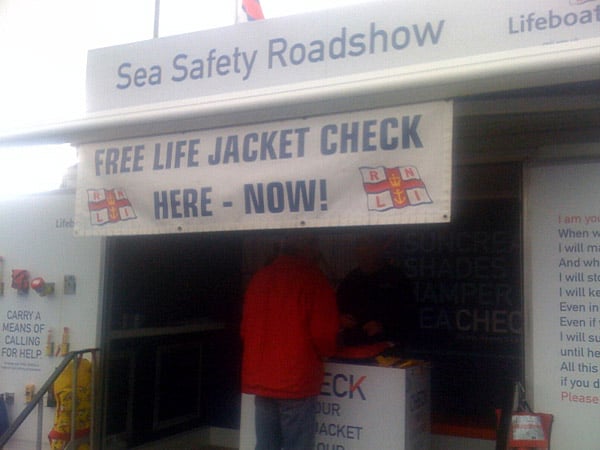
This year the Dun Laoghaire marina initiative with the RNLI aims to get more boat owners, sailors and crews to avail of the free test carried out at the clinic.
The Dun Laoghaire offshore lifeboat will be in the marina's Emergency Berth to allow you to get an close up inspectionand there will be RNLI personnel available to discuss any safety advice or search and rescue questions you may have.
The RNLI will also be taking bookings for a free onboard visit to your boat by the local Sea Safety Officer.
Will your lifejacket work when you need it? Do you know how to make sure it's a correct fit? Do you know how to look after it? All these questions and more will be answered by trained RNLI Sea Safety advisors.
You can learn the importance of choosing, fitting and the maintenance of a lifejacket from 11am to 4pm in Dun Laoghaire at the Lifejacket Clinic with RNLI Sea Safety Team. Likely topics as follows:
Which one?
There are many different types of lifejackets and buoyancy aids on the market. We can help you decide which one is best suited to your needs.
What size?
Size matters! A lifejacket or buoyancy aid will only work properly if it is properly fitted. We can show you how to adjust the lifejacket to a proper fit and why crotch straps are an essential part of the kit.
Looking after it.
It is essential to look after the buoyancy aid or lifejacket properly. With proper maintenance and regular servicing, your lifejacket will last longer and you can ensure it remains reliable. At our lifejacket clinic you can find out what checks to carry out on your lifejacket and how to care for it.
When to wear it?
RNLI volunteer crew wear a properly fitting lifejacket with crotch straps whenever the go afloat on the lifeboat, no matter what the weather. The RNLI believes that lifejackets are useless unless worn. All too often, RNLI crews recover people from the water who were not wearing lifejackets, and have not survived. A lifejacket can buy you time for the rescue services to get to you.
Two Rescued from Cruiser on Lough Derg
At 12.24hrs September 7 Lough Derg RNLI Lifeboat launched, following a request by Valentia Coast Guard to assist a vessel aground close to Terryglass Harbour at the Northern end of Lough Derg. The lifeboat, with helm Johnny Hoare, Ger Egan and David Moore on board, was alongside the casualty vessel at 12.51hrs. Winds were West Southwest, Force 4 gusting 5, with frequent squally showers reducing visibility.
The vessel was aground very close to the shore and the two persons on board were safe and unharmed. Two other passengers had walked to shore and made their way by road to Terryglass Harbour. The vessel had got into difficulties after it had gone to the assistance of another cruiser; this other vessel had made it's way to safe water and was tied alongside at Terryglass Harbour when the lifeboat arrived on scene. The vessel was taken off the rocks at 13.25hrs, she had suffered a lot of damage to her props but was not holed. With an RNLI crew member on board the vessel was towed to Terryglass and was tied alongside at 13.50hrs.
The lifeboat returned to station was ready for service again at 14.35hrs. Helm Johnny Hoare said that he was "pleased with the progress of the rescue considering the conditions on the lake and the position of the boat in very rocky water".
Sail Training Vessel Rescued by Weymouth RNLI (Video here.)
The crew of the Weymouth RNLI relief Severn class all-weather lifeboat Beth Sell assisted a 24 metre sail training vessel with 16 persons onboard that was dismasted South of Portland Bill. The footage taken by crew members iphones and pentax hand held camera. SCROLL DOWN FOR VIDEO
Storms continued to batter Britain and Ireland's coast today as autumn arrived with a roar as forecasters warned the unsettled conditions could last for two weeks.
The Sail Training Vessel's wooden 90ft tall mast broke in half in the force seven winds and the boom, sail and rigging plunged into the choppy 12ft seas.The crew of the stricken yacht, who were all young adults, were unable to retrieve the stricken mast in the poor conditions and called the Coastguard for help.
The Weymouth RNLI lifeboat rushed to the scene at around 5.35pm yesterday.
None of the sailors were injured in the incident, although some were suffering from seasickness in the rough conditions.
The Daily Mail has more here
100 Boats Expected for Saturday's Cobh to Blackrock Yacht Race
This historic race – sponsored by the Port of Cork – will again feature strongly as one of the biggest events supporting this years Cork Harbour Open Day
Starting at midday off Cobh Promenade the race will continue along its traditional route passing Ringaskiddy, Monkstown, Passage, across Loch Mahon and along to the finish at Blackrock Castle.
All boats are then invited to continue up to the City Quays where complimentary berthing will be provided by the Port of Cork at the Cork City Marina.
A barbecue and usual refreshments will be available at the Boardwalk Restaurant (just opposite the City Pontoon) along Lapps Quay. The prize-giving will take place during the afternoon at the Boardwalk. Crews, their families and friends will have plenty of time to relax and enjoy themselves as we wind up the CSC laptop (and operators) to collate the dozens of times across all manner of classes in to a meaningful set of results.
The club would appreciate it if competitors would come along to support the after race festivities and prize-giving, especially if you think you may have won something. As always, the race is free to enter and a collection will be held for the RNLI during the afternoon.
A Wedding Gift that Will Save Lives at Sea
Newly married couple Jackie and Peter Gracey have presented RNLI Bangor Branch with a cheque for £1403.86. Three weeks ago Mr and Mrs Gracey held a wedding party at the Ballholme Yacht Club and in lieu of wedding presents they had requested that a donation be made to Bangor RNLI.
The presentation was made during the RNLI Bangor Lifeboat BBQ held at Ballyholme Yacht Club.
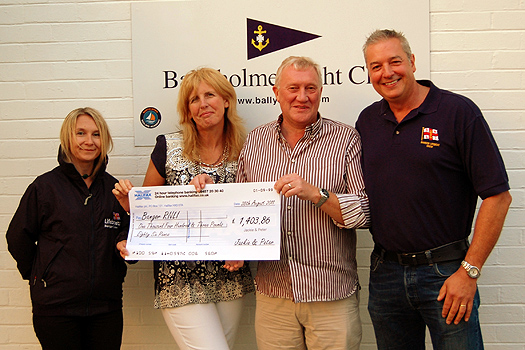
Jackie and Peter (centre) present their cheque
During the evening crew members and guests raised over £1500.00 for the Royal National Lifeboat Institution Bangor Branch.
RNLI senior helmsman Kyle Marshall said 'We would like to thank everyone who attended the crew BBQ and helped raise this fantastic sum of money.' He added 'Special thanks must go to Jackie and Peter; their very special wedding gift will save lives at sea, on behalf of the crew at Bangor Station I would like to wish them a very happy future together.'
Lifeboat volunteer crew at Bangor have launched on service numerous times this year, in all weather conditions and on many occasions during the hours of darkness.
The majority of call outs have been to leisure craft including canoes, powerboat, yachts and speedboats. Difficulties have been caused in the most part by mechanical failure of one kind or another. The rescues have been diverse, taking RNLI's Bangor Lifeboat right across Belfast Lough to Black Head and up towards Belfast as far as the M3 bridge over the River Lagan. Rescues are not always confined to boats in distress. A number this year have been related to suspected attempted suicides and missing persons, others have been to people stranded on rocks caught by the rising tide.


























